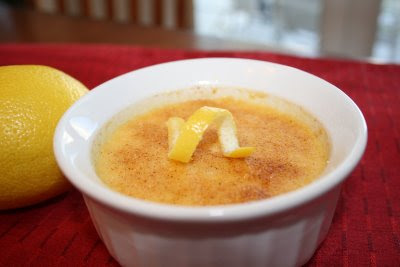

The attraction of creme brulee is the contrast between cold, creamy custard and the warm, crunchy caramelized sugar on top. To achieve this, the custard is first baked in a bain-marie, or a water bath, then cooled and chilled. The bain-marie prevents a crust from forming across the top before the center of the custard is fully cooked.
When the custard has chilled for several hours a layer of sugar is sprinkled across the top and the custard is set under a broiler or a butane hand torch is used to quickly melt & caramelize the sugar. This leaves the custard cold and smooth while the topping is warm and gets crunchy as it cools. Torching the custard is done at serving time and can look pretty impressive but with very little work involved.
The origin of creme brulee is hotly contested, as are many dishes I've researched. It seems all the countries were getting the same brainstorms around the same time. lol
The earliest mention of creme brulee is in a French cookbook by Francois Massialot in 1691 but in his 1731 edition he changed the name of the same recipe to read creme anglaise. My guess as to why he would do this is to appeal to the English market as well as the French.
Trinity College in Cambridge, England claims that they were the creators of creme brulee, calling it Trinity Cream or Cambridge Burnt Cream in 1879. They use a branding iron in the pattern of the college arms to caramelize the top of each custard.
There is another version of creme brulee that hails from the Catalan region of Spain, aptly named Crema Catalana, and it also claims to be the predecessor of France's creme brulee.
While creme brulee is traditionally flavored only with vanilla (other flavors can be used, such as chocolate, fruit or liqueurs) the Catalan version is flavored with lemon or orange zest and cinnamon. The Crema Catalana is not however, baked in a bain marie, as the creme brulee is.
I have tried many versions of creme brulee and there are two that stand out for me. A lemon creme brulee made with the bain marie method and a super easy creme brulee cheesecake. Both are actually easy and both require refrigeration time, but that allows for making these a day ahead if you plan to serve them for a special event.


No comments:
Post a Comment